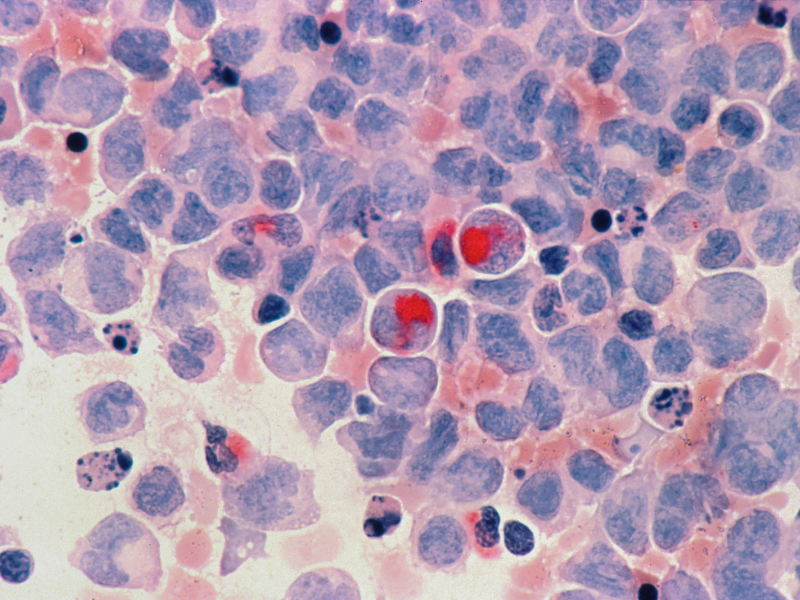Nilesh Kalariya, PhD, AGPCNP-BC, AOCNP
The bispecific antibodies have shown an impressive response rate with tolerable safety profile in patients with relapsed and refractory multiple myeloma (R/R MM). The Food and Drug Administration (FDA) approved two bispecific antibodies, talquetamab (Talvey, Janssen Oncology) and elranatamab (Elrexfio, Pfizer), in August for R/R MM.1, 2
Talquetamab-tgvs
Talquetamab is designed to target G-protein coupled receptor class C group 5 member D (GPRC5D) present on the surface of plasma cells and CD3 receptor expressed on T cells. This IgG4 antibody has a proline, alanine, alanine scaffold which is designed to minimize Fc-receptor binding. The GPRC5D is an orphan receptor which is also expressed in hard keratinized tissues, skin, and tongue.
MonumenTAL-1 study
The FDA approval of talquetamab was based on the pivotal MonumenTAL-1 study, which is an open label, single arm, multicenter clinical trial (NCT03399799, NCT04634552).3. At data-cutoff, the study enrolled a total of 232 patients among which 102 patients were treated intravenously and 130 patients were treated subcutaneously. Among 232 evaluable patients, the average age was 64 years (range 33-84), 30% of the patients were ≥70 years old, and 57% were male. The median number of prior anti-MM therapies was 6 (range 2-20.). The patients’ refractory disease status included triple- (79%), and penta-refractory disease (30%). Based on the revised MM International Staging System (R-ISS), the percentage of the patients with stage I, or stage II, or stage III was 34.3%, 44.1%, and 21.4% respectively. The percentage of patients with high-risk cytogenetics abnormality was 16%, which included del(17p) (9.5%), t(4;14) (8.0%), and t(14;16) (1.1%).
The overall response rate (ORR) was 68% (range 58%-76%) (95% confidence interval [CI]) among patients who were treated subcutaneously with most active dose ranges, 135 to 800 μg/kg weekly and 800 to 1200 μg/kg every other week. Among responders with subcutaneous administration, 53% patients had very good partial response (VGPR) or better. However, the ORR was 72% (range 46%-90%) (95% CI) among patients who were treated intravenously with most active doses of 20 to 180 μg/kg weekly. Among responders with intravenous administration, 61% patients had VGPR or better.
The pivotal MonumenTAL-1 study reported that 88.6% (n=156) of the patients had grade 3 or higher adverse events.3 Most of these higher-grade adverse events were hematological, including 33.5% neutropenia, 30.1% anemia, 14.2% thrombocytopenia, 17.6% leukopenia, and 46.5% lymphopenia. Any grade cytokine release syndrome (CRS) and neurotoxic effects were observed in 61.3% and 7% of the patients, but only 3% and 3% of the patients had grade 3 or higher, respectively. Other notable any grade non-hematological adverse events were skin-related events (42.6%), dysgeusia (46.6%), nail-related events (27.8%), and rash-related events (23.8%).
Elranatamab-bcmm
Elranatamab is a bispecific antibody designed to target B-cell maturation antigen (BCMA) on plasma cells and CD3 on T cells. It is a humanized immunoglobulin 2-alanine (IgG2a) kappa antibody derived from two monoclonal antibodies, an anti-BCMA monoclonal antibody and an anti-CD3 monoclonal antibody. Thus, elranatamab is constructed from a heavy chain and a light chain from an anti-BCMA and an anti-CD3 monoclonal antibodies.
MagnetisMM-3 study
The FDA approval of elranatamab was based on the pivotal MagnetisMM-3 study, which is an open label, single arm, multicenter registration phase 2 clinical trial (NCT04649359).4 The study enrolled a total of 187 patients among which 123 patients had no prior BCMA-directed therapy while 64 patients had prior BCMA-targeted therapy. The results from 123 patients (no prior BCMA-directed therapy), who received subcutaneous elranatamab, were considered for priority review for FDA approval. Among 123 evaluable patients, the median age was 68 years (range 36-89), and 55.3% were male. The Eastern Cooperative Oncology Group (ECOG) performance status of 1 or 2 at baseline was noted in 63.4% patients. 31.7% of patients had extramedullary disease. The median number of prior anti-MM therapies was 5 (range 2-22.). The patients’ refractory disease status included triple- (96.7%), and penta-refractory disease (42.3%). Based on the revised MM International Staging System (R-ISS), the percentage of the patients with stage I, or stage II, or stage III was 22.8%, 55.3%, and 15.4% respectively. The percentage of patients with high-risk cytogenetics defined as del(17p), t(4;14), and t(14;16) was 25.2%.
The ORR was 61% (range 51.8%-69.6%) (95% CI) and 56.1% of patients had VGPR or better including 35.0% with complete remission or better. The ORR was higher in patients with R-ISS stage I-II, and those without extramedullary disease or penta-refractory disease.
The pivotal MagnetisMM-3 study reported that all patients (100%) experienced at least one or more any grade treatment-emergent adverse events including 70.7% of the patients with grade 3 or higher adverse events. The percentage of patients with grade 3 or higher hematological adverse events included 37.4% anemia, 48.8% neutropenia, 23.6% thrombocytopenia, and 25.2% lymphopenia. Any grade cytokine release syndrome (CRS) and neurotoxic effects were observed in 57.73% and 3.4% of the patients, but none of the patients had grade 3 or higher, respectively.
Due to the continuous subcutaneous administration requirement for all bispecific antibodies, one should also be monitoring for potential injection site reactions. Target-specific adverse events vary across bispecific agents. For example, GPRC5D-targeted agent (talquetamab) is associated with specific toxicities such as skin toxicity, nail toxicity, and dysgeusia, while BCMA-targeted agents (elranatamab, teclistamab) are associated with heightened susceptibility to infectious complications.
One of the advantages of bispecific antibodies is that it allows for immediate dosing in an “off-the-shelf” format. This advantage would hopefully provide accessibility and choice to BCMA- or GPRC5D- targeted bispecific therapies to MM patients.
Table. Talquetamab vs Elranatamab
| Talquetamab | Elranatamab | |
| Targets | GPRC5D and CD3 | BCMA and CD3 |
| Availability | Single-dose vials: 3 mg/1.5 mL (2 mg/mL) and 40 mg/mL | Single-dose vials: 76 mg/1.9 mL (40 mg/mL) and 44 mg/1.1 mL (40 mg/mL) |
| Hospitalization | 48 hours after administration of all doses within step-up dosing schedule | 48 hours after administration of the first step-up dose, and for 24 hours after administration of the second step-up dose |
| Pretreatment medications | Acetaminophen 650 mg or 1000 mg orally or equivalent Dexamethasone 16 mg orally or intravenously or equivalent Diphenhydramine 50 mg orally or intravenously or equivalent | Acetaminophen 650 mg orally or equivalent Dexamethasone 20 mg orally or intravenously or equivalent Diphenhydramine 25 mg orally or equivalent |
| Dose | Weekly schedule: 0.01 mg/kg on Day 1 0.06 mg/kg on Day 4 0.4 mg/kg on Day 7 0.4 mg/kg once weekly Biweekly schedule: 0.01 mg/kg on Day 1 0.06 mg/kg on Day 4 0.4 mg/kg on Day 7 0.8 mg/kg on Day 10 0.8 mg/kg every 2 weeks | Weekly schedule: 12 mg on Day 1 32 mg on Day 4 76 mg on Day 8 76 mg once weekly Biweekly schedule (ONLY for responders starting week 25): 76 mg once biweekly |
| Route | Subcutaneous | Subcutaneous |
| Boxed warnings | CRS Neurotoxic effect | CRS Neurotoxic effect |
| Warnings and precautions | Oral toxicity Skin toxicity Cytopenias Weight loss Infections Hepatotoxicity Embryo-fetal toxicity | Neutropenia Infections Hepatotoxicity Embryo-fetal toxicity |
| BCMA, B-cell maturation antigen; CRS, cytokine release syndrome; GPRC5D, G-protein coupled receptor class C group 5 member D. | ||
Nilesh Kalariya, PhD, AGPCNP-BC, AOCNP, is a nurse practitioner in the Department of Lymphoma/Myeloma at The University of Texas MD Anderson Cancer Center, Houston, Texas.
References
- Talquetamab prescribing information. Available at https://www.accessdata.fda.gov/drugsatfda_docs/label/2023/761342s000lbl.pdf
- Elranatamab prescribing information. Available at https://www.accessdata.fda.gov/drugsatfda_docs/label/2023/761345s000lbl.pdf
- Chari, A., Minnema, M. C., Berdeja, J. G., Oriol, A., van de Donk, N. W. C. J., Rodríguez-Otero, P., Askari, E., Mateos, M. V., Costa, L. J., Caers, J., Verona, R., Girgis, S., Yang, S., Goldsmith, R. B., Yao, X., Pillarisetti, K., Hilder, B. W., Russell, J., Goldberg, J. D., & Krishnan, A. (2022). Talquetamab, a T-Cell-Redirecting GPRC5D Bispecific Antibody for Multiple Myeloma. The New England journal of medicine, 387(24), 2232–2244.
- Lesokhin, A. M., Tomasson, M. H., Arnulf, B., Bahlis, N. J., Miles Prince, H., Niesvizky, R., Rodrίguez-Otero, P., Martinez-Lopez, J., Koehne, G., Touzeau, C., Jethava, Y., Quach, H., Depaus, J., Yokoyama, H., Gabayan, A. E., Stevens, D. A., Nooka, A. K., Manier, S., Raje, N., Iida, S., … Mohty, M. (2023). Elranatamab in relapsed or refractory multiple myeloma: phase 2 MagnetisMM-3 trial results. Nature medicine, 29(9), 2259–2267.








